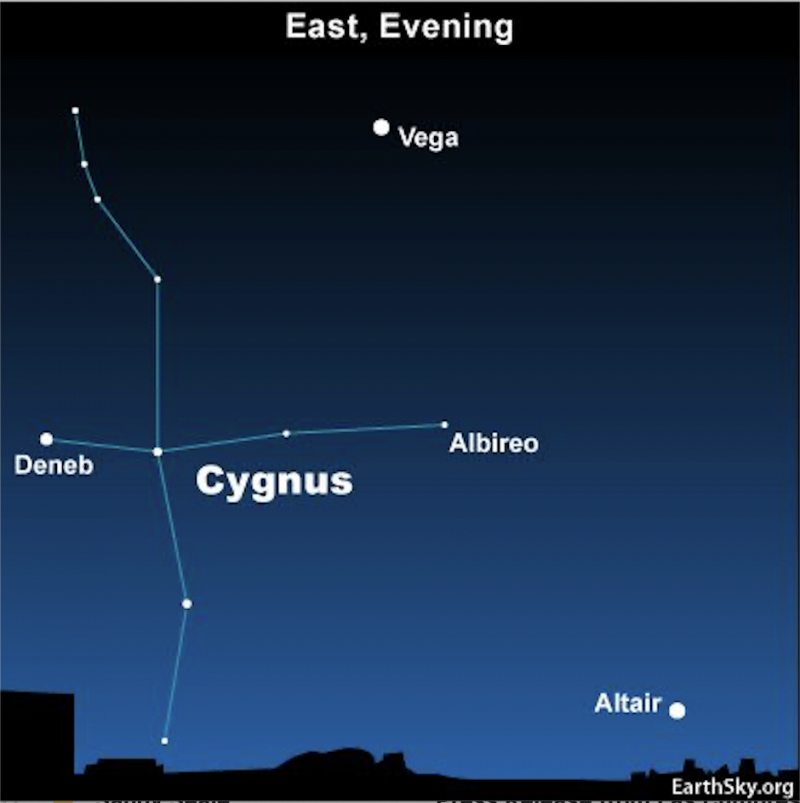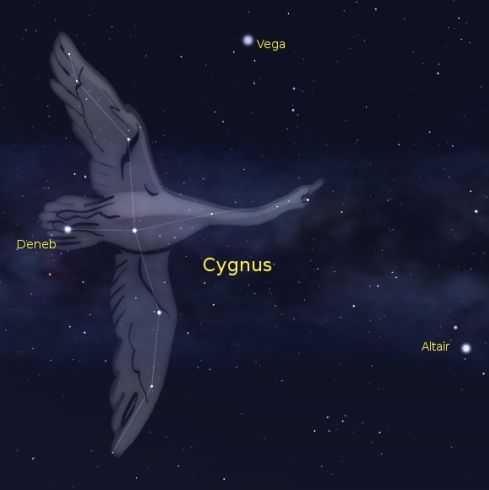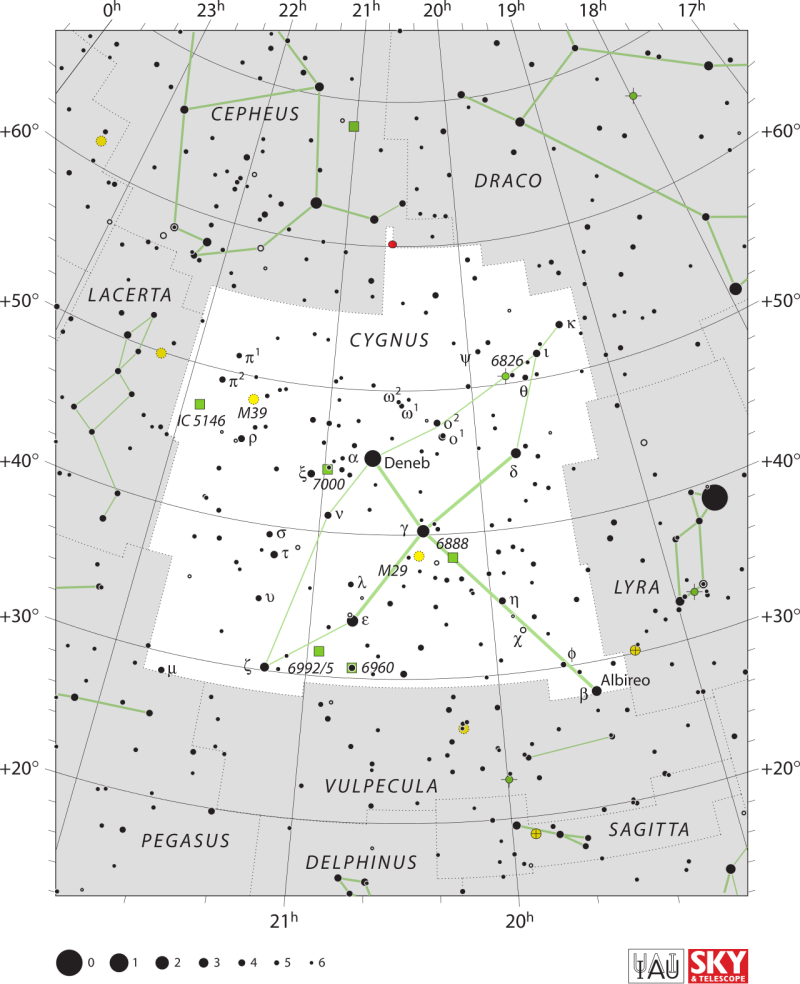
How to find the Northern Cross
The Northern Cross is a clipped version of the constellation Cygnus the Swan. It’s an asterism, or pattern of stars that’s not a recognized constellation. It lies embedded within another, much larger asterism, the Summer Triangle. You’ve got to have a dark sky and a good imagination to see a swan in the stars of Cygnus. But the Northern Cross is easy to see, even if your sky is less than pristine.
Here’s step #1 to finding the Northern Cross (or Cygnus the Swan). Look for the most brilliant star in the Cross, Deneb. Deneb marks the top of the Northern Cross. It’s also well known as one the three bright stars of the Summer Triangle, along with Vega and Altair.
Roughly halfway between Altair and Vega, and somewhat offset toward Deneb, look for the brightest star in that part of the sky. That’ll be Albireo. Although a modestly bright star, Albireo is easy to see on a clear, dark night. Since there are no similarly bright stars near Albireo, it’s fairly easy to find.
Once you locate Deneb and Albireo, you’re halfway to piecing together the Northern Cross. All you need now is the crossbar, which most people see as three moderately bright stars. In the illustration below, you’ll see these three stars extending about halfway out into the wings of Cygnus the Swan.

Backbone of the Milky Way
In a dark sky, the Northern Cross serves to point out the Milky Way, the edgewise view into our own galaxy. The Milky Way appears in a dark sky – in the evening in northern summer – as a luminescent river of haze, passing directly through the Northern Cross. This hazy band stretches all across the sky on late July and August evenings.
You probably know this “haze” is really myriad stars. You can see the haze explode into stars by aiming binoculars toward the Milky Way.
Keep in mind, also, that all the stars we see with the eye alone belong to our home galaxy, the Milky Way.
When you look at the Northern Cross, you’re looking directly into the Milky Way’s flat disk, where most of our galaxy’s stars reside. In fact, the galactic plane (equator) runs right through the Northern Cross, encircling the sky above and below the horizon.
On some clear, dark night, use binoculars and the Northern Cross to enjoy the star fields, star clusters and nebulae that abound within the disk of the Milky Way galaxy!

Northern Cross as a marker of seasons
As seen from mid-northern latitudes, the Northern Cross is out for at least part of the night all year around. It’s out all night in summer. On Northern Hemisphere summer nights, the Northern Cross shines in the east at nightfall, sweeps high overhead after midnight, and swings to the west by daybreak. When you see the Northern Cross in the east on summer evenings, it’s sideways to the horizon.
By the time northern autumn arrives, the Northern Cross is still out from nightfall until midnight, but it appears high overhead in the evening and sets in the northwest after midnight.
When winter comes, the Northern Cross is standing upright over your northwest horizon.

Bottom line: The Northern Cross is an “asterism” or recognizable pattern of stars, part of the constellation Cygnus the Swan. Charts and more here to help you find it in your sky.
The post Northern Cross: Backbone of Milky Way first appeared on EarthSky.
from EarthSky https://ift.tt/2UkTXfy

How to find the Northern Cross
The Northern Cross is a clipped version of the constellation Cygnus the Swan. It’s an asterism, or pattern of stars that’s not a recognized constellation. It lies embedded within another, much larger asterism, the Summer Triangle. You’ve got to have a dark sky and a good imagination to see a swan in the stars of Cygnus. But the Northern Cross is easy to see, even if your sky is less than pristine.
Here’s step #1 to finding the Northern Cross (or Cygnus the Swan). Look for the most brilliant star in the Cross, Deneb. Deneb marks the top of the Northern Cross. It’s also well known as one the three bright stars of the Summer Triangle, along with Vega and Altair.
Roughly halfway between Altair and Vega, and somewhat offset toward Deneb, look for the brightest star in that part of the sky. That’ll be Albireo. Although a modestly bright star, Albireo is easy to see on a clear, dark night. Since there are no similarly bright stars near Albireo, it’s fairly easy to find.
Once you locate Deneb and Albireo, you’re halfway to piecing together the Northern Cross. All you need now is the crossbar, which most people see as three moderately bright stars. In the illustration below, you’ll see these three stars extending about halfway out into the wings of Cygnus the Swan.

Backbone of the Milky Way
In a dark sky, the Northern Cross serves to point out the Milky Way, the edgewise view into our own galaxy. The Milky Way appears in a dark sky – in the evening in northern summer – as a luminescent river of haze, passing directly through the Northern Cross. This hazy band stretches all across the sky on late July and August evenings.
You probably know this “haze” is really myriad stars. You can see the haze explode into stars by aiming binoculars toward the Milky Way.
Keep in mind, also, that all the stars we see with the eye alone belong to our home galaxy, the Milky Way.
When you look at the Northern Cross, you’re looking directly into the Milky Way’s flat disk, where most of our galaxy’s stars reside. In fact, the galactic plane (equator) runs right through the Northern Cross, encircling the sky above and below the horizon.
On some clear, dark night, use binoculars and the Northern Cross to enjoy the star fields, star clusters and nebulae that abound within the disk of the Milky Way galaxy!

Northern Cross as a marker of seasons
As seen from mid-northern latitudes, the Northern Cross is out for at least part of the night all year around. It’s out all night in summer. On Northern Hemisphere summer nights, the Northern Cross shines in the east at nightfall, sweeps high overhead after midnight, and swings to the west by daybreak. When you see the Northern Cross in the east on summer evenings, it’s sideways to the horizon.
By the time northern autumn arrives, the Northern Cross is still out from nightfall until midnight, but it appears high overhead in the evening and sets in the northwest after midnight.
When winter comes, the Northern Cross is standing upright over your northwest horizon.

Bottom line: The Northern Cross is an “asterism” or recognizable pattern of stars, part of the constellation Cygnus the Swan. Charts and more here to help you find it in your sky.
The post Northern Cross: Backbone of Milky Way first appeared on EarthSky.
from EarthSky https://ift.tt/2UkTXfy

Aucun commentaire:
Enregistrer un commentaire